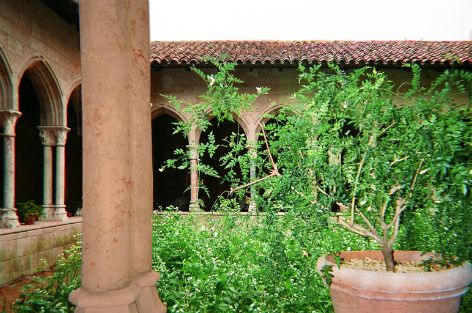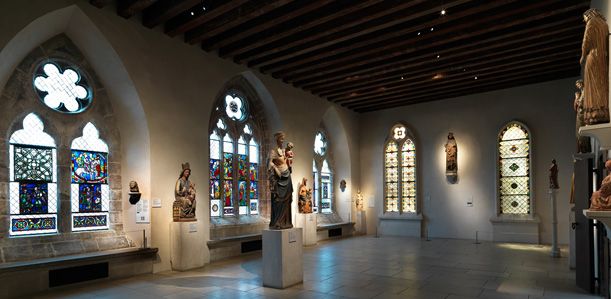Part of the reason I'm using the Cloisters is to show how a medieval, European, background bears the historical and cultural references to the New World. And New York is the epitome of the New World. Although visiting the Cloisters seems to take us back in time, the Hudson River below, and the George Washington Bridge in the distance soon brings us back to the present - to the New World.
The periwinkle seems to embody that. The flower originated in Europe, and was brought over to North America in the 1700 as a horticultural plant.

The Trie Garden in the Cloisters
Discussed in: Garden Guide: New York City pp. 33-37
Cloisters Flowers
[Photo by Kidist P. Asrat, August 2012]
The Trie Cloister Garden is home to a collection of plants native to the meadows, woodlands, and stream banks of Europe. Planted as a single filed of herbs and flowers, the garden evokes the verdant grounds of medieval millefleurs tapestries, in which a myriad species are shown blooming simultaneously. Many of the plants gorwing in the garden can be found in the tapestries on display in the galleries, but they bloom here in their proper season.
The European flora is dominated by spring-blooming plants, and the garden is bright with blossoms in early spring, when hellebores, snowdrops, periwinkles, narcissus, violets, wild pansies and English daisies abound, followed by bluebells, columbine, dame's rocket, and iris in May. Foxglove, clary, meadowsweet and ox-eye daisies bloom well into summer. In July the flowering begins to subside, and the Trie becomes a green garden, in which plants chosen for their form and foliage predominate. Acanthus, royal fern, and flag provide a foil for the lesser number of summer-blooming flowers.
Small shrubs like myrtle and sweet gale give structure to the garden, and are repeated throughout to create a pleasing symmetry. In late summer, the cloister becomes a cool refuge, where the air is perfumed by the pots of poet's jasmine that line the parapets. Water splashes from the fountain at the center, and small birds come to drink from the spouts. [Notes from the information booklet]

[Photo by Kidist P. Asrat, August 2012]
As I was looking through my files and notes on the Cloisters, mainly to find an appropriate image for the front cover of my proposed book, I found the above photo I took of the garden. I was struck by a tiny flower, the periwinkle (also known as the myrtle).

Periwinkles in the Cloisters
Discussed in Garden Guide: New York City pp. 33-37
Periwinkle Label:
Common Periwinkle, Myrtle
Vinca minor
[Photo by Kidist P. Asrat, August 2012]
The periwinkle is also featured in a stained glass window on display in the museum. Although I was able to take a couple of photographs, museum guards soon came to me to tell me I couldn't use a flash. I was unable to take photos of the stained glass with the periwinkle motif, but the Metropoltian Museum of Art, of which the Cloisters are a part, have some images on their website, with descriptive notes.
The five panels of this lancet window once decorated three different windows in the radiating chapels of the abbey church of Saint-Ouen at Rouen, in Normandy. As reassembled here, the lancet is only one-third its original height. Grisaille glass, which is colorless and translucent, was a popular glazing device in the thirteenth and fourteenth centuries. It not only allows more light into the interior than color-saturated pot-metal glass, grisaille also functions as an unobtrusive background for ornamental motifs painted with fine brush lines. Our glass panels are decorated with stylized yet recognizable plants such as periwinkle, strawberry, and artemisia, forming an elegant network of foliate motifs. The central bosses of the panels are richly colored with deep blue, red, yellow, and green. The bosses would have echoed the brilliantly hued horizontal bands once located at the windows' midpoints, which contained scenes from the life of the saint to whom the chapel was dedicated.

The Early Gothic Hall, Closters
The Early Gothic Hall houses works from the thirteenth and fourteenth centuries. The three thirteenth-century limestone windows overlooking the Hudson River are filled with Gothic stained-glass panels from the cathedrals of Canterbury, Rouen, Soissons, and other sites. Also on view are French, Spanish, and Italian sculptures of the period, as well as an altarpiece depicting the Adoration of the Shepherds painted by the Sienese artist Bartolo di Fredi about 1374. [Notes from the Metropolitan Museum of Art]

Window with Grisaille Decoration
Date: ca. 1325
Geography: Made in Rouen, France Culture: French
Medium: Pot metal glass, colorless glass, silver stain, and vitreous paint
Dimensions: Overall: 28 1/4 x 23 1/2 in.
The Cloisters Collection
In this fourteenth-century panel, the vibrant color and robust lines of thirteenth-century stained glass were jettisoned in favor of colorless glass painted with leafy vines growing on a trellis. The three foliate designs, each of which is remarkable for its delicacy and refinement, are identifiable not only by their botanical species but also as patterns known to have originated at Saint-Ouen. The two lower panels display the periwinkle flower; the third panel represents the leaf of the strawberry plant; and the top two depict geranium foliage. The colored borders incorporate buttercup leaves with red and green quarries, and the center bosses are composed of whorls of artemisia leaves entwined with knotted ribbons of color. [Notes from the Metropolitan Museum of Art]

Detail of the top square panel of the grisaille, with stylized yellow periwinkles
The plant forms in this detail are too highly stylized to be botanically identified, with the exception of the grisaille flowering vine with silver stain blossoms. This may be tentatively identified as a species of periwinkle, either Vinca major or V. minor, but it is not a botanically accurate representation. Periwinkle flowers are blue, not yellow or gold, but form is more important in the identification of plants in medieval art than color. Even botanically recognizable plants are represented in color forms other than those found in nature. [Notes from the Metropolitan Museum of Art]
In ancient Rome, Pliny wrote in The Natural History of Pliny:
Sprigs of myrtle, if carried by a person when travelling on foot, are found to be very refreshing, on a long journey.
- The information plaque by the periwinkle bed in the Cloisters describes the flower as a medieval cancer treatment:
Annual periwinkles have been used for centuries for folk medicine, especially for treating diabetes, and are the source of several cancer drugs.- And from this site, on the meaning of the flower's name:
The Latin name of periwinkle's genus, Vinca, is derived from a word meaning "to overcome."- In Christian symbolism, the periwinkle represents Gentiles converted to Christ.
Such a small flower, with such a sturdy name!
-------------------------------------------------------------------------------------------------------------------------------------------------------------
Posted By: Kidist P. Asrat
-------------------------------------------------------------------------------------------------------------------------------------------------------------
